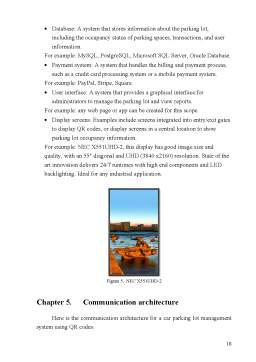Cuprins
- CHAPTER 1. INTRODUCTION 1
- CHAPTER 2. USER NEEDS ... 2
- 2.1 USER NEED 7.1.11.1 2
- 2.2 USER NEED 7.1.11.2 5
- 2.3 USER NEED 7.1.11.3 6
- 2.4 USER NEED 7.1.11.4 9
- CHAPTER 3. FUNCTIONAL ARCHITECTURE .. 13
- CHAPTER 4. PHYSICAL COMPONENTS 16
- CHAPTER 5. COMMUNICATION ARCHITECTURE 18
- CHAPTER 6. ORGANIZATIONAL ARCHITECTURE ... 19
- CHAPTER 7. SECURITY ARCHITECTURE 20
- CONCLUSION ... 21
- REFERENCES ... 22
Extras din proiect
Chapter 1. Introduction
There are several ways to manage traffic effectively and creatively along the road network and address traffic congestion and disturbance (such as planned/unplanned events, accidents, floods, fires, etc.). For instance, a number of cities used various traffic rerouting, traffic prioritization, and access regulation strategies, including intersection management, aimed at all or a specific subset of vehicles (e.g. deviations, priority lanes, green waves, road user charging or tolling, low emission zones, low speed zones and pedestrian zones). Unfortunately, these measures are not always maintained holistically and consistently, and they are frequently incorrectly taken into account in the traffic information systems' outputs to users (e.g. navigation devices). Therefore, optimizing a variety of traffic management and prioritization measures, properly complemented by standardized technological solutions for vehicle identification (i.e. as regards vehicle categorization, emission class, character of emergency, and load factor), would be advantageous from one side. Establishing coherent specifications, compatible standards, and practical interfaces supporting the interoperability of data necessary for up-to-date traffic information from the other side.
Humanity has therefore spent a very long time trying to improve the traffic management system. Any supply chains, tourism, military activities, or even daily commuting would be incredibly difficult without effective traffic flow and logistics.
Access to an HTML representation of a section of the European ITS Framework (FRAME) Architecture is made possible by an Browsing Tool. It makes it possible to observe interactively in Microsoft Internet Explorer the functionality from the functional viewpoint and the allocation of user needs to functionality. Materials that can be read or downloaded from the E-FRAME Deliverables section of the FRAME Web Site provide more details regarding the Functional Viewpoint and the User Needs. By using this tool, for this project, we are going to make an architecture for the traffic management of a city, like Bucharest.
For this project we chose to make a Parking Management system, to improve the car parking lots in the city I live, Bucharest.
A car parking lot management system using QR codes is a modern and efficient solution for managing a public car parking lot. The system uses QR codes
to streamline the parking process and provide a convenient and user-friendly experience for drivers.
With this system, drivers can enter the parking lot and park their cars and pay for parking using their smartphones. The system uses QR code readers, cameras, and a server to manage the parking process, store transaction records, and provide real-time information about the availability of parking spaces. The system can also generate reports and analytics to help the parking lot owner understand the usage of the parking lot and make informed decisions.
The design of a car parking lot management system using QR codes requires a well-thought-out communication, organizational, and security architecture to ensure its efficient and secure operation. This example provides a high-level overview of the components, functionality, and architecture of a car parking lot management system using QR codes.
Chapter 2. User needs
In this chapter I will describe the user needs for the Parking Management system, extracted from Browsing Tool.
2.1 User Need 7.1.11.1
The system shall be able to monitor the current usage of the parking facilities.
Here are the functions that serve this User Need:
3.1.4.1 Monitor numbers of vehicles in Car Parks
This Function shall be capable of providing the following facilities:
(1) The ability to detect vehicles using the entrances and exits of car parks in the urban road network.
(2) The ability to collect the data as raw input by sensors that are capable of detecting the passage and presence of all types of road vehicle, from bicycles to Heavy Goods Vehicles (HGV's).
(3) The ability to process the data to provide actual vehicle count data, i.e. numbers of vehicles, using the entrances and exits of each car park.
(4) The ability to send the processed data to other functionality for collation and use in traffic management.
Functional Requirements:
(a) the presence of the trigger input data flow shall be continuously monitored
(b) the analogue data representing the raw traffic flow data obtained in (a) shall be converted into digital data that separately shows the numbers of vehicles entering and leaving the car park
(c) the data for each car park in the urban road network shall be kept separate and split into vehicles entering and leaving
(d) the trigger output data flow shall be used to send the data in (c) to the Calculate Car Park Occupancy and Status function.
Bibliografie
[1] CbrowsingHomePage - new_V9+.html
[2] https://www.a2t.ro/camere-supraveghere-exterior/camera-exterior-4-in-1-hikvision-2mp-ir-20m-ds-2ce16d0t-irpf-c.html?gclid=CjwKCAiA_vKeBhAdEiwAFb_nrceABmG-VvXnE-4Qa-DQhj73DGme4J9pvlanyrImVXNmPPXvKL5xIRoC9HAQAvD_BwE
[3] https://servermall.com/sets/dell-r330-servers/?utm_source=google&utm_medium=cpc&utm_campaign=EU_PerfMax_Network_DELL.18996168865&utm_content=...&utm_term=&placement=.&gclid=CjwKCAiA_vKeBhAdEiwAFb_nrZQ4XPAGBwBbgk54UCnpHUs1hZUmRlomYAMCILNsbJK6QZRCuQxN-RoCazUQAvD_BwE
[4] https://www.sharpnecdisplays.us/products/displays/x551uhd
Preview document
Conținut arhivă zip
- Parking Management system for Bucharest.pdf
























